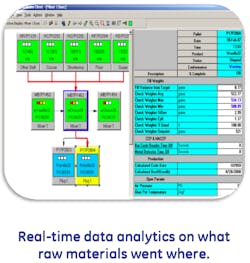The Food Safety Modernization Act (FSMA), the first major overhaul of U.S. food safety practices since 1938, has food processors’ attention. It aims to ensure the U.S. food supply is safe by shifting the focus of federal regulators from responding to contamination to preventing it. Draft regulations from the U.S. Food and Drug Administration (FDA) have been open for public comment but are not yet final. In the meantime, food processors are getting educated on the possible changes, and on ways to adapt or enhance their manufacturing systems to accommodate them.
What some are finding is that the same track-and-trace systems that monitor and report on the provenance of ingredients and other batch record details can be used to improve efficiency and profitability.
Katie Moore, global industry manager for food and beverage for GE Intelligent Platforms (GE-IP), gave presentations on the FSMA and track and trace at PackExpo Las Vegas 2013. She talked with Automation World later about ingredients tracking, GE-IP’s 25 years of supporting food and beverage manufacturers, and her own experience as a plant manager for Bimbo Bakeries USA.
“There’s a lot of uncertainty” among manufacturers waiting for the FSMA regulations to be established, says Moore. But what she talked about in her presentations is “integrating [FSMA compliance] with other things you’re looking at. Track and trace is a means to an end, and is basically reactive. But you can take track and trace and flip it. You can use the same systems and work processes to be more proactive,” she says.
A lot of times, manufacturers deal with projections and best guesses, “but if you have actual information and you can track it specifically, you can really use the data to save money,” says Moore. “Some of our customers—brewers, for example—use [workflow and track-and-trace technology] to understand utilities usage, to trace and reduce energy costs.”
GE-IP’s Proficy Workflow software (Version 2.1 came out last month) integrates with existing automation and control systems to guide operators through proper steps to meet objectives. It helps organizations replicate their best practices within their plant or around the world to increase quality while decreasing costs.
Mark Bernardo, general manager of automation software for GE Intelligent Platforms, says one North American manufacturer used Proficy Workflow to enhance its manual batch management with these results: 40 percent decrease in waste, 70 percent increase in operator productivity and 20 percent boost in capacity. “The company addressed quality consistency issues, unpredictable cycle times, and variations in production efficiency across operators due to level of experience,” Bernardo says.
Moore cites the example of a GE-IP customer who makes jams and jellies. “They get a batch of fruit, but it may have ripened more than expected in transit. If operators know it in real time, they can adjust their recipe in real time and make the same jar of jelly every time—get consistent quality—without adding additional sugar,” she explains. “The customer tests incoming batches of fruit for sugar content, and all information is linked, so whatever specs are in the certification of analysis and in any internal analysis are attached to each lot number.”
Because food manufacturers often do rework and reprocess ingredients, well-detailed batch systems also track how ingredients change. “The system says you made this product on this day and used that ingredient as part of this rework batch,” says Moore. “Our system tracks everything that goes in that tank until it’s CIP [cleaned in place], so you know what you’ve got inside that batch.” It also provides real-time visibility into actual ingredient use, rather than just planned use.
Some batch management systems may not track everything, ignoring “ingredients” beyond raw materials like flour, sugar and water when making bread, for example. But other important parts of a batch record should be the labeled bag the loaf of bread goes into, and even the plastic clip to close it.
“The No. 1 FDA recall is for a mismatch of ingredients to packaging,” says Moore. “Finding out that you’re out of packaging when you’ve got a loaf of bread coming out of the oven is not good. If I accidentally put an allergen in that batch, or I put it in the wrong package, I’m in trouble. The data has to match all the way from start to finish.”
GE-IP has been helping food processors digitize work processes and enable track and trace systems for years, says Moore. What’s different now is that the systems are now simpler and more affordable. “We’re providing more out of the box capabilities from a food safety perspective,” she says.
Customers also better understand that “operational excellence is a journey, and they can get a roadmap for continuous improvement,” adds Moore. The result is repeatable, consistent operations—from common tasks to critical emergencies—that minimize errors and risk, reduce waste and ensure compliance.
About the Author
Renee Bassett
Managing Editor

Leaders relevant to this article:
